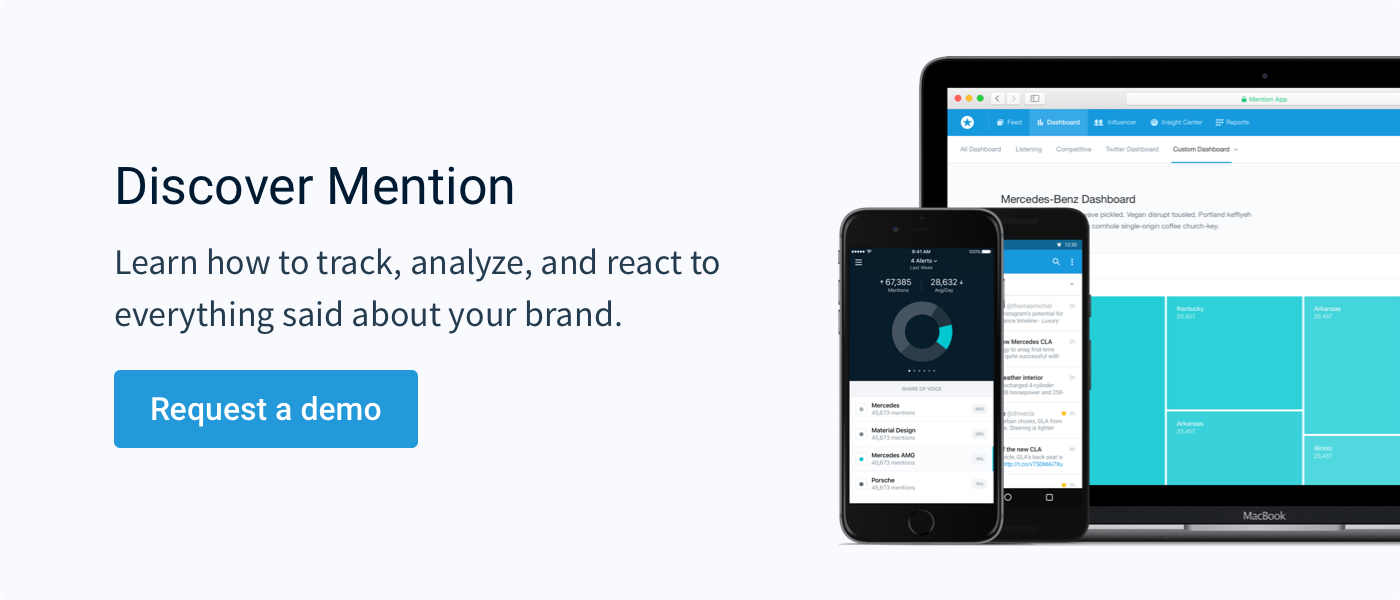I’m all about efficiency.
For example, by keeping snacks next to me at all time, I save time by not having to stand up and walk to the kitchen every time I want a snack. Given how often I want a snack, that’s some real productivity there.
So one of my favorite things about Mention is that it lets you be more efficient in lots of different ways. For one, we’ve built a lot of features into the app itself that can save your whole team a lot of work, but that’s not even what I’m talking about today.
My favorite productivity feature is how well it works with other tools I use on a daily basis. But I’m always surprised at how many people I talk to never look into what apps their business tools integrate with.
But true Mention power users know how convenient it can be to just hook your alerts and other parts of the tool into the rest of your business. So today let’s look at some the integrations that could be saving your team time.
6 integrations that make Mention more powerful
1. RSS
Let’s start with the most basic. You can create a simple RSS feed to add to an RSS reader like Feedly or hook into another tool. It’s a simple way to work your Mention alert notifications into your other notifications.
For example, if you’re already using Feedly to follow other favorite blogs in your industry, you can also pipe your industry monitoring alerts into the same place while taking advantage of Mention’s strong monitoring.
To find the RSS feed for any alert, just click the settings icon that pops up when you hover over an alert’s name to edit the alert. Then, at the top of the page, there’s a link to generate the RSS feed:

You’ll be able to customize the feed so that you’re either receiving notifications for all mentions, priority only, or mentions you’ve favorited in the app.
2. Facebook, Twitter, & Instagram
Next up for simple integrations are your favorite social media platforms.
Where your alert can monitor almost any website, there are a few social networking sites where you can take it one step further. Instead of just monitoring, reading, and analyzing content on these sites, you can also connect your social accounts to interact with it.
To get started, click your account avatar at the top right corner of the screen and head to your account settings. Then click over to the ‘Social Accounts’ tab, and you’ll be able to add accounts from there:

Once a network is connected, you’ll be able to take social actions on mentions from that site. For example, by connecting your Twitter account, you can like, retweet, quote, or reply to tweet mentions.
3. Buffer
You may have noticed one option in the above screenshot that’s not like the others. Yep, we integrate with Buffer too!
That means in addition to any content creation options you already have for social networks, like sharing a Facebook post or quoting a tweet, you can also add that content to your Buffer queue to live with the rest of your social media content, and publish it according to your social media calendar.
To get this integration going, just follow the directions in the previous section, and connect your Buffer account instead of one of the networks themselves. After that, the Buffer icon will show up as an action item for mentions.
4. Slack
Slack is one of those tools where, if you use it, you have it open all day, everyday. So it’s nice to get as much information there as you can, which we talked about in our post all about Slack integrations.

This integration can both send all your new mentions into Slack so you don’t need to check your dashboard as often, as well as creating a daily digest of your alert like in the graphic above.
With the mention notifications, you can get real-time notifications in any Slack channel, which also makes it an easy way to share content with the rest of your team. You can also customize and filter the notifications so that, for example, you’re only getting Slack messages for mentions from influential websites and users.
Then the digest email lets you quickly see the “health” of your alert and get a summary of whatever you’re monitoring. It sends every morning, just in time to answer your boss when they ask, “how are we doing on social?”
To start getting Mentions in Slack, first connect your account by going to settings, heading to the “Integrations” tab, and following the directions from there. Then to add individual alerts to your Slack team, select “Add to Slack” on the “Edit Alert” page and you can customize the notification settings from there.
5. Zapier
As a big old automation nerd, the Zapier integration is my personal favorite. Zapier is a tool that basically lets you connect all your business apps and customize your own integrations. And since it connects with hundreds and hundreds of apps, this article should really be titled something like “A Bajillion Integrations” instead of just eight.
Zapier works to let you create and automate integrations by setting up rules like “when this happens in App A, do this in App B.” When you connect Mention, you’ll be able to use new mentions, new alerts, and new sources of mentions (like a certain website or Twitter user) to trigger actions in other apps.
For example, if you keep your team’s product roadmap in a Trello board and also use monitoring to collect product feedback from customers, you can favorite mentions with ideas you want to pursue and automatically send them to that board. Save your product manager some time moving information from one app to another and ensure all ideas are organized.

To get started, connect Zapier through the Integrations tab and then head over to their site to create your first zap!
6. Mention API
The last integration on this list is…drumroll please…your own integration. If none of the above tools accomplish what you need, you can use our API. You can build your own in-house monitoring tool using our data, add monitoring data to your own products to help customers save time, or plug data straight into your reports.
For inspiration, read up on how other smart businesses use the Mention API.
Power up
See how many great business tools you can power-up your Mention account with? Monitoring is just part of your overall social media and communications, and easily connecting it to other parts of your business makes monitoring more productive.
Subscribe to Marketing + Monitoring Weekly
Get hot blog posts, insanely useful resources, and funny gifs every Friday.

